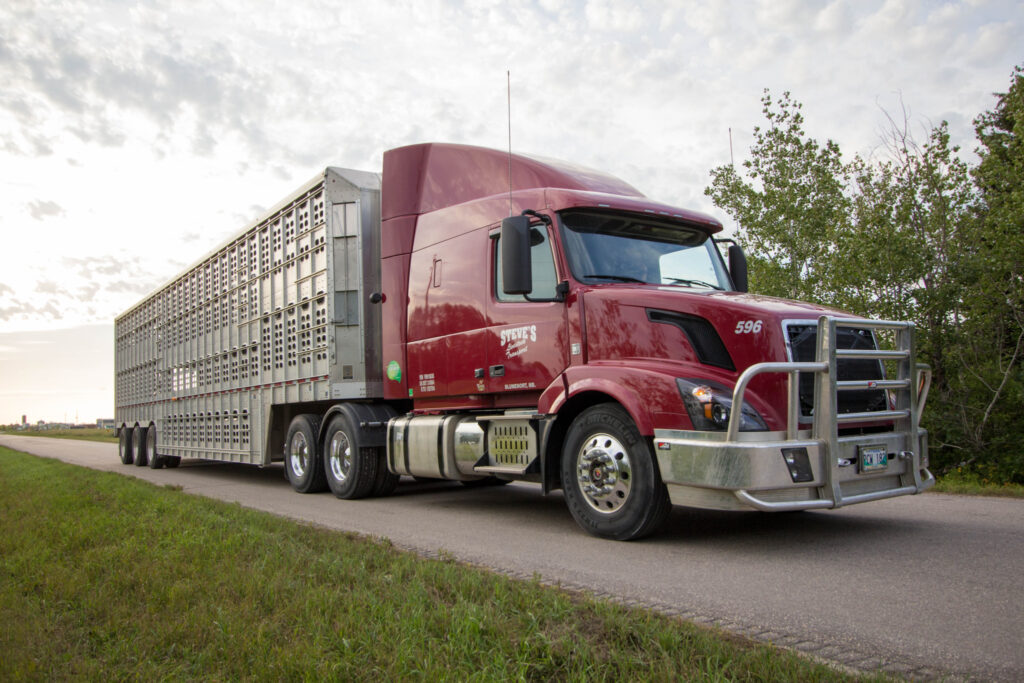Hauling livestock during Covid-19
BLUMENORT, Man. – Steve’s Livestock Transport drivers are well isolated as they complete their regular shipments. Footwear and clothing are changed before animals are unloaded. Trailers are washed, disinfected, and in some cases even dried before the next shipment.
That was before any talk of Covid-19.
“The benefit we have with the livestock side is we’re very used to biosecurity,” says Bill Rempel, CEO of the 140-truck fleet, one of the largest commercial livestock carriers in North America.

But there are clearly new policies and procedures to embrace in the midst of the pandemic.
Meat processing facilities have been epicenters of some of the largest workplace outbreaks of Covid-19. Three employees at Cargill’s facility in High River, Alberta died of the virus, and more than 1,500 workers tested positive, leading to a two-week shutdown. The JBS Foods plant in Brooks, Alberta – which has reported 650 cases and one death – returned to two shifts per day on Thursday after weeks of reduced operations.
It’s hardly business as usual.
The additional steps adopted by Steve’s Livestock during Covid-19 will sound familiar to other fleets in the midst of the pandemic. Documents are now handed over digitally rather than in a paper form. The flow of trucks and drivers through customer facilities is more strictly controlled in the name of physical distancing.
“They’re not all bad changes,” Rempel stresses, referring to the use of electronic documents as an example. “We’ve used technology in a way that we didn’t think was possible. We have dispatchers working from home … We have the infrastructure here to support that.”
Inside company offices, boardrooms have been commandeered as work spaces. Employees are expected to remain six feet apart.
New procedures were also put to the test when a regional driver tested positive for the virus.
“We already had a process in place on how to do the trace backs,” Rempel says, noting how managers contacted everyone who would have come into contact with the driver. Fourteen days later they were given the all clear. There was no further spread. The driver recovered.
“That was a bit of a scare,” he admits.
Scheduling in the shop
New scheduling demands represent some of the biggest ongoing hurdles. The company’s maintenance operation, BVT Truck and Trailer Repair, runs three shifts. Mechanics are assigned to individual service bays, but gaps are now needed to move personnel in and out. As one shift ends, workers are encouraged to leave right away. The following shift arrives at the last minute, and heads in only after new cleaning and disinfecting protocols are completed.
“For the most part, we looked at 30 minutes to have one shift completely out of the building,” Rempel says. Gone are the days when arriving early would be encouraged. Workplace efficiency has dropped a bit as a result.
Still, freight volumes have been “more or less flat,” Rempel says of the weeks since governments began to respond to the virus.
But that’s in a broad context. “Cattle is moving but not at normal volumes – and I would call it disruptive right now,” Rempel says. “Our customers are telling us they are still holding significant amounts of cattle that they are not able to ship right now, and in some cases they are being directed to different plants.”
At the peak of Cargill shutdown, the Canadian Cattlemen’s Association reported a backlog of 100,000 head of cattle. Close to 6,000-9,000 head were added to the total each day.
Even where plants didn’t shut down, new policies have led to cancelations and delays, Rempel says. The number of empty miles has increased. Delivery hours have shifted. Traditional lanes change direction from one week to the next.
“We’ve seen about a 30% reduction in retail work at our repair shop,” he adds. While freight volumes with the fleet’s LTL operation surged in early weeks of the economic shutdown, they have since slowed down as well.
But the business continues, and he says Steve’s Livestock is doing what it can to show some extra appreciation to the drivers who continue their work behind the wheel. For six weeks they’ve handed out gift cards for things like fuel and groceries. Freezers have been stocked with meat. Employees are simply asked to write down what they take.
“It’s going to look different, and I think that’s OK,” Rempel says, referring to what business will probably look like in the months to come.
“We’re going to journey through this together.”
Have your say
This is a moderated forum. Comments will no longer be published unless they are accompanied by a first and last name and a verifiable email address. (Today's Trucking will not publish or share the email address.) Profane language and content deemed to be libelous, racist, or threatening in nature will not be published under any circumstances.
Steve’s Livestock is a class act, I have had the pleasure of working with them in the past and can attest to their conviction to do the right things right – all of the time.